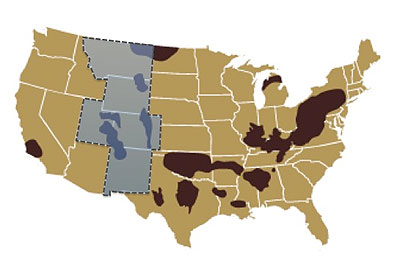| University of Colorado at Boulder | ||||||
 |
||||||
|
LawAtlas Database - Water QuantityThe LawAtlas Water Quantity dataset captures laws and regulations addressing the amount of water used in oil and gas development, including water administration systems, reporting requirements and disposal methods — all of which provide a picture of the life cycle of water use in the hydraulic fracturing process. Laws and regulations compiled for 17 states, three federal agencies (Bureau of Land Management, Bureau of Indian Affairs, and U.S. Forest Service), and three local jurisdictions may require those drilling to identify the physical source of water used for development, submit a water plan, and to identify the amount of water used during completion of the well, the amount of water that flows to the surface after hydraulic fracturing, and the volume of disposed water. The laws and regulations also address how surface and groundwater rights are obtained and whether the state distinguishes types of surface water and groundwater. A factsheet: Oil & Gas Operations: Creating Successful Water Policies in Colorado, State Laws Regulating the Life Cycle of Water in Oil and Gas Development gives a brief description of the types of state laws that regulate water monitoring and tracking in oil and gas operations. It also provides examples of policies that Colorado could adopt to improve life cycle analysis and suggests recommendations for drafting such policies based on best practices from other states. ColoradoProduced Nontributary Ground Water Rulemaking:Ground water in the State of Colorado is legally presumed to be "tributary," or hydraulically connected to surface water in such a fashion so as to require administration within the prior appropriation system in conjunction with surface rights, unless it is demonstrated to be nontributary ground water in accordance with the law. This rulemaking defines specific locations of Nontributary Ground Water. 2 CCR 402-17 Relevant RegulatorsColorado Oil and Gas Conservation Commission MontanaRelevant RegulatorsMontana Board of Oil and Gas Conservation New MexicoRelevant RegulatorsNew Mexico Oil Conservation Division UtahRelevant RegulatorsUtah Division of Oil, Gas and Mining WyomingWater Exports RestrictionExports of water from Wyoming of over 1,000 acre-feet per year require regulatory permission and must follow a statutory process laid out in WS 41 -3-115. This statute would not effect smaller developers, however a number of developers in Weld County, Colorado would use enough water if they solely sourced from Wyoming exports. Relevant RegulatorsWyoming Oil and Gas Conservation Commission Beyond the RegionTexas's Oil & Water Tightrope TEXAS Relevant RegulatorsThe Railroad Commission of Texas (RRC) is responsible for regulating all waste associated with oil.
|
||||||





